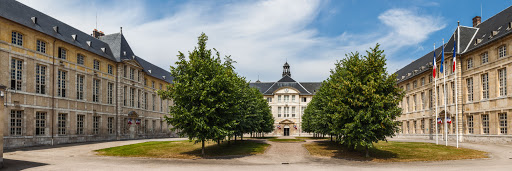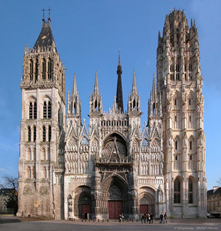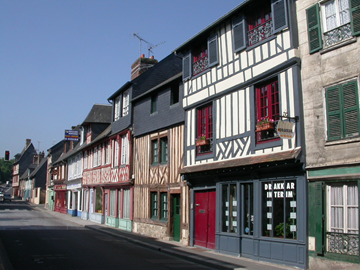Gustave Flaubert’s relationship with Rouen and Normandy is ambivalent. I love you too… He was not gentle with his fellow citizens when he wrote about it in his letters, but he lived there for most of his life and only wrote really well when he was at his work table in Croisset. Deeply imbued with these places, he chose them as the setting of two novels and a tale.
Rouen
Flaubert spent his youth in Rouen, where his father worked as a chief surgeon, in an office building at the Hôtel-Dieu. When he died in 1846, he moved with his mother to a large mansion on the banks of the Seine at Croisset, where he died in 1880.

You just have to go through the index of Flaubert’s correspondence, at the entrance «Rouen», to see more and more friendships with regard to his «stupid homeland», the «infectious Rouen», etc. In fact Flaubert hates Rouen because he was born there and because he lives there. Discovering Nantes during his trip to Brittany, he writes: “it is not worth Rouen either […] that I would like if I had not been born there”. This rejection of the place of birth and residence is a constant of the Romantic era, during which the artist defines himself as opposed to the bourgeois, claiming his marginality. He attributes his pain of living to the time and place, and dreams of other times and distant lands. In the same century, Stendhal executes Grenoble, Rimbaud flees Charleville.The diatribes against Rouen and the Rouennais are mainly found in his correspondence and will not be published until after his death. However, they became public in 1872 in a pamphlet against the Rouen ediles, who refused to grant a site to erect a monument to his friend Louis Bouilhet: “Conservatives who keep nothing… Before sending the people to school, go yourself! Enlightened classes, enlighten yourselves!" Flaubert also despised the industrial capital of the Seine-Inférieure at the time, that of spinners and cotton merchants. Their main flaw: to be interested only in the useful, to consider art as an entertainment.
Rouen plays a central role in Flaubert’s first novel, Madame Bovary, and is the subject of numerous realistic or magnified descriptions. Flaubert paints the industrial landscape, but also the superb panoramic view from the top of the Neufchâtel road, which he describes through Emma’s loving eyes. Rouen will be the place of youth for Charles and that of adventure for Emma. As this one follows with its finger on a map the streets of Paris where it will never walk, we can go through the places haunted by the characters of the novel around 1840: Charles, student at the Collège Royal, then student in medicine lodging rue Eau-de-Robert (sordid at the time, tourist today), Emma at the convent of the Ursulines, the street of Ernemont, a representation at the Théâtre des Arts (then at the bottom of la Rue du Grand Pont.
Finally Flaubert brings out, through memorable scenes, the cathedral of Rouen, where Emma meets Leon, and the city that they crisscross in a cab at the whim of inappropriate zigzags. The cathedral returns in Trois contes, as a documentary: «And this is the story of Saint Julien l'Hospitalier, such as is found, on a church stained glass window, in my country.» Here, the storyteller speaking in the first person joins the author. The last of the tales, Herodias, also finds one of his inspirations in the tympanum of the Saint-Jean portal, which represents the feast of Herod, the dance of Salome and the decoupling of John the Baptist.
Flaubert, which identifies with its emblematic monuments, has a presence in the city of the hundred steeples: «I have at my heart something of the green oozing of the Norman cathedrals.»

Croisset and la Seine
Flaubert’s real address is the one that appears in his letters: «Croisset, près Rouen». The purchase by the family of this beautiful residence on the outskirts of Rouen allowed him to retire, after a nervous crisis, at the beginning of 1844. Croisset is not only a quiet place, it is a way for Flaubert to stay away from «industrial literature», far from Paris and newspapers. Like any legend, that of «the hermit of Croisset» is only half true, for Flaubert will spend about a third of his adult life in Paris. But the image corresponds to the author, who saw art as a religion, and his life as that of a saint in the desert, cursing his century. What he calls his “shack” or “shack” is not just a place to write; he sees in it the very condition of the exercise of literature. He worried that the bankruptcy of his niece, risking the sale of the house, would ruin the very possibility of writing.
Flaubert wrote in his large office on the first floor of the «white house» with a view of the Seine. Far from her, during his trip to the East, he has a nostalgia for it: There on a less ancient river I have somewhere a white house whose shutters are closed now that I am not there. … I left the long terrace lined with Louis XIV lime trees where I strolled around in my white bathrobe in summer… ] I left the large wall lined with roses with the pavilion at the edge of the water.”
This pavilion at the edge of the water which is still visited today, is the only vestige of the house of Croisset, demolished a year after the death of Gustave to leave room to a factory. The Seine with its boats is present in the life and work of Flaubert: the giant with the look of a sperm whale bathes there «like a newt»; it connects the Norman maternal side to the Champagne paternal side; it cuts Rouen in two opposite banks, Gothic and modern in Madame Bovary.
Flaubert died in his home on 8 May 1880. He was buried in Rouen with his family and his friend Louis Bouilhet. It occupies a small white tomb to the monumental Cemetery that dominates Rouen and from where one can guess Croisset, at the curve of the Seine.

Normandie
Flaubert also had a confrontational relationship with his province, both consubstantial and distant. He felt Norman when he wrote to Louise Colet: "I carry within me the melancholy of the barbarian races." Maxime Du Camp says that during their trip to the Orient, looking at «African landscapes, he dreamed of Norman landscapes». But next to these «desires of Normandy», we find many signs of rejection, when he writes for example: «Normandy with its greenery annoys me teeth like a dish of raw sorrel», or: «I know nothing more despicable than Normandy.»
In his work, the status of Normandy reflects his relationship with his native province. Her first novel, Madame Bovary, subtitled «Moers de province», is based on a Norman geography at the same time real, with the cities of Rouen and Tôtes or Tostes and imaginary: Flaubert takes the name of a Rouen source to create «Yonville», planting in the country of Bray, a village more typically Norman than all the real communes. Flaubert talks about the territory he knows to describe the boredom and mediocrity of a village. However, he seeks a universal vision, since both the «poor Bovary, undoubtedly, suffers and weeps in twenty villages of France at the same time».
He refuses any picturesque idealization, unlike Balzac for the Touraine, or George Sand for the Berry. He wrote to Louise Colet on April 10, 1853: "My compatriots will roar, for the Norman colour of the book will be so true that it will scandalize them." This unflattering local Norman colour permeates both places, characters, situations, the prosaic way of «seeing things», and even expressions. He presents Yonville and its region as follows: We are here on the borders of Normandy, Picardy and Île-de-France, a country where language is without emphasis, like the landscape without character. This is where the worst Neufchâtel cheeses are made in the entire borough, and on the other hand, it is expensive to grow them, because it takes a lot of manure to fatten up this crumbly land full of sand and pebbles.”
It was not a given that Flaubert’s unfinished work also took place in Normandy. The author had first thought of Houdan. The encyclopedic crossing of the two copyists, largely above ground and out of time, could take place anywhere. But finally: «I will place Bouvard and Pécuchet between the valley of the Orne and the valley of Auge, on a stupid plateau, between Caen and Falaise», he writes to his niece Caroline, June 24, 1874. The set setting, the novel will remain anchored in this Norman landscape, Flaubert making a voyage of discovery there in September and October 1877.
For the geography of Un cœur simple, the first of these Trois contes (1877), Flaubert chose Pont-l'Évêque, Honfleur, and Trouville, the place of origin of his mother and his own teenage loves. It was then a nostalgic and soothed Normandy that he staged; a return to maternal territory that served as the setting for Félicité’s modest life.
